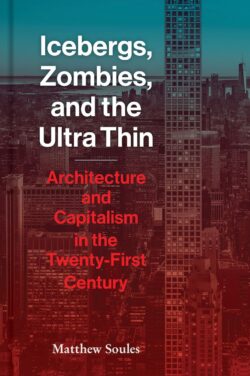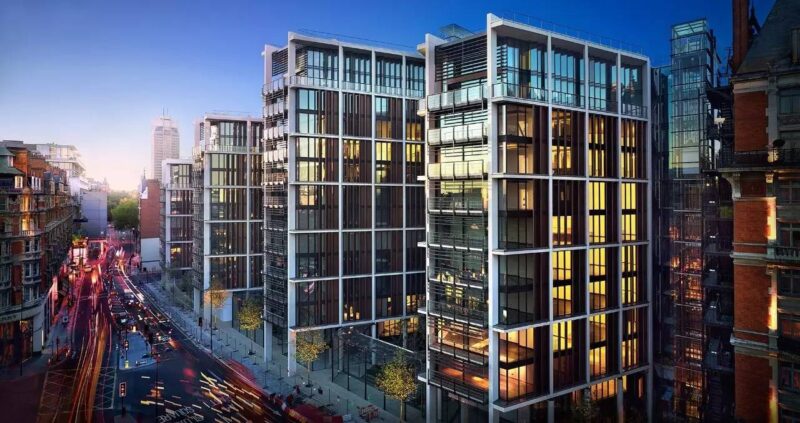1242 Architecture, investment, & greed
Icebergs, Zombies and the Ultra Thin: Architecture and Capitalism in the Twenty-First Century
by Matthew Soules
Hudson, NY: Princeton Architectural Press, 2021
$26.95 (U.S.) / 9781616899462
Reviewed by Theo Dombrowski
*
 Everyone says many of the same things about real estate. “That view is worth a million dollars.” “If you want to make money, real estate is a sure bet.” “Choosing a house? Location, location, location. “ “Young people today can’t possibly own a house.” “Those foreigners are buying up our city and driving up prices.” “Why would rich people invest in empty housing if they have to pay property taxes?”
Everyone says many of the same things about real estate. “That view is worth a million dollars.” “If you want to make money, real estate is a sure bet.” “Choosing a house? Location, location, location. “ “Young people today can’t possibly own a house.” “Those foreigners are buying up our city and driving up prices.” “Why would rich people invest in empty housing if they have to pay property taxes?”
Enter the catchily titled Icebergs, Zombies and the Ultrathin by Matthew Soules, an architect and urbanist teaching at UBC. The subtitle of his book is a little less catchy but crucial: “Architecture and Capitalism in the Twenty-first Century.”
It may be reassuring that he confirms the truth of what we all say. Reassuring, however, is hardly the tone of his book. In fact, very much the opposite. To the common principles that we lay public generally understand, he has given enormous depth and broad global context. And, more important, he has coupled these with the very opposite of common wisdom: his book will be for most readers one revelation after another.
These revelations take many forms, but what emerges most prominently is that much urban architecture has not just a dark side, but many, many dark sides. It’s likely that many of us have been naive. Many of us have looked at new constructions and thought, “That new condo’s inventive design is clearly intended to enhance the city’s skyline !” Or we might have thought, “That new complex looks so welcoming with its grouping of towers around treed gardens, pools, shops and amenities: now there’s an architect who believes in making city dwelling liveable.” We might even have thought, “It’s great that there are building projects with social benefits. Some of these luxury building projects produce funds for public projects.” With Soules’ penetrating analysis of the tactics behind and consequences of apparently well-intentioned building projects, we can’t help but leave the dizzying pages of his book feeling just a little frayed.
In order to deepen his book’s impact, Soules has carefully employed many techniques. Essentially an “academic” study, his book nevertheless will have a broad appeal to anyone willing to furrow the odd brow or follow a closely argued sequence of ideas. To help matters along, he begins with an introduction that carefully lays out the topics of each chapter—though this may be particularly useful as an overview summary read a second time after reading the book.
Rich in content, the book is nevertheless short. Further to make life easy, Soules breaks his text into short units, each introduced by a well-centred title like “Simultaneity of Growth and Decay” or “Philanthropic Urbanism.” Some of these titles are even a little playful: consider “Style Omnivores and Sheltered Taxes” or “Life, Death, and Finance Capitalism.”

To develop his study, Soules employs, as two of his many devices, statistics and examples. He handles both with such control and focus that the reader can’t help but be engaged. Some are connected to detailed examples — of this “zombie” development here, that “iceberg” house there, that “superprime” condominium elsewhere. His description of London’s “One Hyde Park,” for example, is full of startling details of design. It is grounded further in such eye-popping statistics as the fact that a penthouse there was “refinanced” for $213 million. Clear and precise, such statistics are managed in a way that they are never dizzying, even though their implications are stomach churning.
To these two main principles of development, as we might expect of an academic book, Soules makes use of a welter of sources and end notes. However, his touch is always nimble, his references not turgid, but illuminating.
And, most important for a book on architecture, this one includes diagrams and photos — lots of them. The effects of these are electric. Some show sprawling, empty developments, ghastly and bleak, some demonstrate byzantine residence plans, some depict spectrally preposterous skyscrapers.


The writing style, also as we might expect of an academic book, is based on careful, measured use of terminology and handling of syntax. Eschewing empty jargon, Soules nevertheless does use terms that may be unfamiliar at first, but that he carefully explains and repeats in such a way that they become familiar and useful. Terms like “superprime,” “REITs,” and, crucially, “finance capitalism” quickly and easily become part of the reader’s lexicon. On the other hand, instead of using words that his readers themselves might reach for — like “pretentious” — he opts for “aspirational.” But we get the message. Instead of saying “filthy rich” he uses the proper term UHNWI — hilariously, perhaps, meaning “ultra high net worth individual.” Indeed.
More important, though, he infuses his generally measured tone with such depth of sincerity and such humanity, that even fairly dense sections are utterly gripping. In addition, when his bitterness does break through, it has all the more impact because it is comparatively rare. Even though the tone is usually more that of an “exposé” than a polemic, the author’s deeply humane values give enormous substance to the writing. In the first part of the book, a lot of his most felt choices of words are in the captions to his photos. Here we see a bleak set of empty walls in Ireland that he describes as “uncanny.” Elsewhere we see an “exurban investment mat” (that is, a vast suburb designed solely as a vehicle for investment) as “flowing over the landscape like lava.” Outside Mexico City an almost endless spread of identical units he captions “relentless.”
In the text itself, the raw tone can be particularly effective. In a section called “The Financial Good Life,” for example, Soules writes acridly that “Finance capitalism traffics [my italics] in a long-standing conception of the good life.” He dismisses the leisure facilities on offer as a “playscape,” while decrying the current “alienated pursuit of pleasure.” At another point, in describing an “ultra thin” tower (remember the title?) he writes with dry sarcasm, “The slender tower helps inhabitants avoid the neighbor’s [sic] noisy television and smelly meals or, heaven forbid, the sight of the neighbor in the hallway.” Point made.
Of course, it is the book’s deeply serious content that really matters most. And this is where the key word in the subtitle, “Capitalism” rears its head.
Everyone is familiar with the claims of capitalism’s virtues. Probably the most prominent is that capitalism encourages innovation. To the extent that that is true, it assumes that capitalism is engaged in production. Amongst the various points that Soules makes early in his book, however, is that that notion of capitalism is based on outmoded premises. He doesn’t argue: he calmly and coolly gives the stats. Capitalism is no longer based on production. It is overwhelmingly based, instead, on abstractions … on finance, on investment in money, on making money from money. It is, in short, “finance capitalism.”
But that is the background of this book. The foreground is architecture and, primarily, residential architecture. What can be the link? After all, buildings are a kind of production aren’t they? If capitalistic incentive pulses through architecture, at least its innovations are surely directed towards something tangible, places where you can season your pasta and curl up under your duvet.
While the subtitle of the book is its real topic (of course), the lead title is a key to the whole method of the book, namely to take a deeply serious topic and give it an alarming vitality by linking it to the bizarre, disturbing and imagination-gripping.

Enter Toto. Toto is never in this book by name, but he certainly is by principle. Who is the real hero of The Wizard of Oz? Of course, of course, it’s the little dog that pulls the curtain back, back, back, revealing the sordid and self-serving driving force behind the smoke and mirrors that keep the multitudes gaping, awe-struck, and utterly deluded. As Soules says at one point of many of the forces at work in finance capitalism, “From this surreal vantage, everything begins to appear as fiction.”
In this case the curtain that Soules is pulling aside is that between apparent motivation and real motivation. For the developers and architects, that motivation can seem to be civic-minded — to beautify our cities, to provide affordable housing to some and imaginatively striking housing to those who can afford it, to provide investment opportunities to both middle and upper income groups, and so on.

But why are whole, sprawling subdivisions made with identical or nearly identical units? And why are vast tracts of desertscapes built with row after row of apparently empty houses? The reality? What underlies vast swaths of weird, “zombie” development, or even more bizarre “ultra thin” towers, is, according to Soules, solely the desire to create profit. The buildings are not primarily designed as housing at all.
The profit-driven cynicism underlying apparently more socially-minded impulses (whether for beautiful buildings, liveable natural surroundings, or affordability) builds to a kind of climax in the section on “philanthropy.” Here, readers from Vancouver will be particularly struck by Soules’ revelations about one of the most spectacular building projects in BC, the immodestly named Vancouver House.

The deep concern that Soules expresses most is towards those who are left out in the cold while the ultra rich pamper their egos and pad their purses — particularly since, as he points out, the suffering of the former correlates to the wealth of the latter (while admitting the complexity of the connections). In the spectacular case of Vancouver House, where each unit purchased directs money towards a house for the poor in Cambodia, Soules reveals the human tragedy: “Investing happens in Vancouver, while real living happens far away, in a Cambodian slum.” Put in a global context, “a small collection of richly constructed but sparsely inhabited superprime avatar cities exist in tandem with a larger and distant group of surrogate, bodily slum cities.” The strongest impact is of Soules’ profound indignation with greed, rapacity, egoism, and utter disregard for social responsibility.
If the chapter on Vancouver House epitomizes the moral outrage of the book, two subsequent chapters epitomize the conceptual extremes to which the author drives his understanding of the trends in architecture. The earlier chapters of this book could have been approximated by some other knowledgeable and astute analysts sharing similar social values and similar understanding of real estate and building practices. The final chapters, however, could only have been written by someone who has thought deeply about architectural principles, someone with the interpretative energy to penetrate beyond the economic and structural and move into social psychology — and particularly that arising from the impact of symbols and the digital age.

His interpretations of the implications 432 Park Avenue in Manhattan, the astounding “pencil thin tower” evoked by the title of the book– a “transhumanist monument”– take the reader into the heady realms of considering Kurzweil’s infamous “singularity” and the futuristic vision of disembodied life it entails. Here Soules’ interpretative energy is at its maximum, to the point that the book becomes more about the possible nature of the human experience and much of its extra-corporeal properties in the future than about the hard issues of housing.
Indeed, it is one of the key parts of the book’s impact that, throughout, time is the vehicle for the book’s deepest disquiet. “Trend” is too bland a word to describe the alarming rate of increase in the accelerating forces and wealth accumulation that Soule documents throughout the book.
Time gives a further push to the last chapter on “virtual” real estate, a mind-blowing look into the future, however much based on present practices. In this world, profits accumulate as residences are bought and sold that do not yet exist, or, in some frameworks (think: the virtual world of Second Life), do not exist physically at all. Inevitably — are you braced? — “blockchain technology” rears its dizzying head. And if that weren’t enough, “algorithmic trading,” with artificial intelligence run (nearly) amok, pushes the boundaries of greed even further.
But the future doesn’t stop there — of course. In an Epilogue, turning to the context of the covid pandemic and, to boot, of a Vancouver choked with wildfire smoke, Soules directs his final words not to the readers who must struggle their way through the stranglehold of finance capitalism, but to architects, those who have a mission — and a responsibility. “Architecture as a critical and creative act must expand its operational milieu to reassert its purpose in the twenty-first century.”
With the Oz curtain pulled back on the realities behind the facades of buildings and societal forces behind them, Soules appeals to architects to work for the benefit not just of the few, but of everyone.
A fascinating sequel to this book would be one which examined, through surveys and interviews, perhaps, the minds and hearts of those enmeshed in the web, the architects, the developers, and the investors, both those whose gambles paid off and those whose didn’t.
Occasionally we read a book that really matters. This is one of them.
*

Born on Vancouver Island, Theo Dombrowski grew up in Port Alberni and studied at the University of Victoria and later in Nova Scotia and London, England. With a doctorate in English literature, he returned to teach at Royal Roads, the University of Victoria, and finally at Lester Pearson College at Metchosin. He also studied painting and drawing at the Banff School of Fine Arts and at UVic. Editor’s note: Theo has written and illustrated several coastal walking and hiking guides, including Secret Beaches of the Salish Sea (Heritage House, 2012), Seaside Walks of Vancouver Island (Rocky Mountain Books, 2016), Family Walks and Hikes of Vancouver Island (RMB, 2018, reviewed by Chris Fink-Jensen), as well as When Baby Boomers Retire. He has reviewed books by Karen Hofmann, Barry Kennedy, Ann Shin, Lynne Quarmby, Deni Ellis Béchard, Aislinn Hunter, and Anne Enright, among others, for The Ormsby Review. Visit his website here. Theo Dombrowski lives at Nanoose Bay.
*
The Ormsby Review. More Books. More Reviews. More Often.
Publisher and Editor: Richard Mackie
The Ormsby Review is a journal service for in-depth coverage of B.C. books and authors. The Advisory Board consists of Jean Barman, Wade Davis, Robin Fisher, Cole Harris, Hugh Johnston, Kathy Mezei, Patricia Roy, Maria Tippett, and Graeme Wynn. Scholarly Patron: SFU Graduate Liberal Studies. Honorary Patron: Yosef Wosk. Provincial Government Patron since September 2018: Creative BC
“Only connect.” – E.M. Forster
4 comments on “1242 Architecture, investment, & greed”